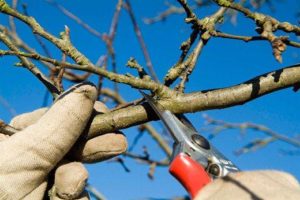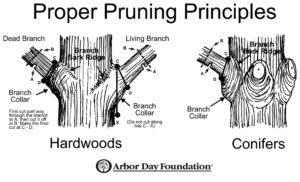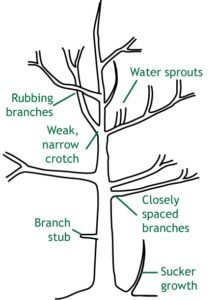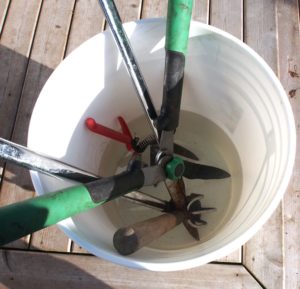There’s something about the beginning of the fall season that makes people eager to start pruning. Perhaps it is the onset of winter? Or Perhaps it’s all the raking and mulching that has people going overboard in their yard?
But before you start pruning your trees and shrubs, you may want to tune in to what the landscape experts have to say.
The leading minds in the green industry are recommending that you prune nothing in the fall. That goes for trees, shrubs, & perennial plants & grasses.
Now this may lead you to feel like you are way out of your comfort zone. It is important to reassure yourself that fall is simply not the right time to prune. Not even to trim trees and shrubs, though the fallen leaves have exposed all their imperfections. Pump you brakes and put your pruning tools back in the shed for at least a month or so. Here is an explanation and some pruning basics, to be implemented when it’s a more opportune time to trim back trees and shrubs:
Why Not Prune In Fall
Pruning in fall stimulates new growth just when the plants are trying to go dormant, and this severely weakens the plants. Furthermore if you prune on a warm day, sap rises up into the plant; then it drops below freezing that night, and you run the risk of losing your plant entirely. This risk is only increasing due to the continually shifting weather patterns we are experiencing now & into the foreseeable future.
Instead, prune in the dead of winter or in early spring. Consider it an exercise in self control over your fall pruning obsession. Keep in mind that you can prune spring bloomers right after they finish flowering. Proper pruning of flowering shrubs will help the plants produce more flowers, which can also benefit wildlife. Being mindful of your pruning timing can also help trees and shrubs avoid infectious diseases and unwanted interest from pests. Waiting until winter means that most woody plants are dormant, and because leaves have already fallen, it makes it easier for you to see what you’re doing. For early spring bloomers (like Rhododendron & Viburnum) that only need light pruning, prune them just after they finish blooming. For very overgrown deciduous shrubs, winter pruning is in all likelihood the best approach.
Scientists are finding that numerous pollinators use grasses and perennials as a overwinter habitat. That habitat is becoming harder and harder for them to find due to our overzealous cleaning of our yards. Birds also browse seed heads for food. Consider leaving at least some of your plants as an experiment. Tell yourself its ‘winter interest’.
Never Prune When It’s Wet
As a general rule of thumb, don’t prune when experiencing damp conditions outside. Doing so spreads a lot of diseases. Damp weather encourages the growth of microorganisms & fungi that will thrive on the open wounds left from pruning. Wait until the sun’s out for a while. Give the heat the opportunity to dry out and kill mold & bacteria.
Pruning Is An Art
Cut the branch as close to the source as you can without creating a ‘flush cut’. Cut at the same angle as the branch collar ( the furrow of bark where branch and trunk meet) so that the plant can seal over the wound. If you leave a stub sticking out, it’s an area for bacteria and insects to harbor.
Pruning is essential to allow more sunlight and air circulation to filter through the trees and shrubs. This will help to keep them healthy. When it’s time to prune, first focus on removing dead or dying branches. If you see a sickly branch, cut between the diseased spot and the body of the plant. Also remove branches that turn inwards, rub, or cross each other. Typically you cut the smaller branch off. Also consider removing a branch if it is growing vertically. You can also take off really low branches that could interfere with foot traffic or lawnmowers. Keep the amount of material pruned off between 15-20% of the total plant.
Know the limits of your pruning ability. If you can’t trim from the ground using pole pruners/saw, or if there’s any pruning to be done near power lines, make sure you hire a professional instead of climbing and taking on the dangerous task yourself.
Know What You Are Pruning
There are numerous trees and shrubs that you can prune from winter until the sap starts flowing again in spring. Others you may want to wait to prune until after they bloom so that you do not sacrifice next years flowers by pruning at the incorrect time. It is important that you identify the plant before you prune to determine the optimal time to do so.
Keep Tools Clean
No matter what type of pruning tools you decide to use, make sure you keep them clean! Especially if you’ve cut out diseased branches. It is imperative that you sterilize your tools thoroughly before moving on to another plant, to avoid spreading disease. You can disinfect the tools by using just a teaspoon or two of bleach in warm water. Some prefer to use disinfectant wipes, alcohol, or zerotol. Hot, soapy water also kills most germs. Remember to dry (and possibly oil) tools well after washing, too.
You should be comfortable & confident in your yard. If you have any questions about pruning timing, technique, plant identification, or you just need help we are only a phone call or email away.








